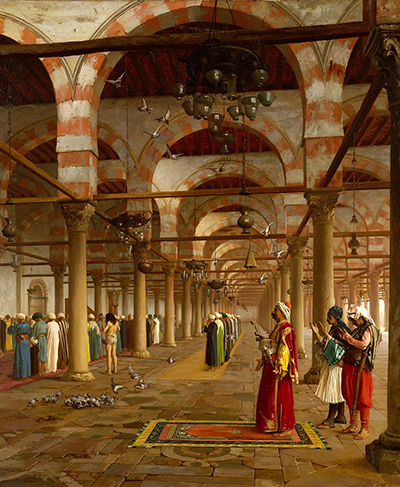This depiction of the interior of the ‘Amr located in the seventeenth century Cairo, Egypt was done by Jean-Leon in the year 1868 after he visited the location.
Setting and location
Right from the foreground to the background of the painting, there is the obvious presence of worshippers gathered to take part in one of the five sessions of prayer held daily. The row of worshippers ranges from the loincloth-clad Muslim man to the dignitary plus his attendants who are seemingly facing Mecca. Whether or not the artist witnessed this prayer session in that particular Mosque is, however, subject to argument since by the year 1868 it had already fallen disuse. It is probable that Jean-Leon came up with this painting as a composite of photographs and sketches he had taken from different sites that he had visited since he had widely travelled as evidenced by two-thirds of his paintings that are essentially devoted to Orientalist subjects.
Technique and approach
He uses an intricate blend of brushworks to bring out the dynamism in visual effects by diagonally intersecting the cross beams with the verticals of the column. The upper section of the painting, approximately a third is dedicated to seemingly repetitive shapes of the horseshoe arches and flying pigeons around the chandelier. This kind of division enabled the artist achieve some form of structured architectural elements that were instrumental in creating a feeling of balance in the masterpiece.
Furthermore, Jean-Leone manages to lay emphasis on the architecture of the mosque by creating shadowy and light-filled depths the juxtaposition of repeating patterns of white and red, which quintessentially depicts a sense of quiet reverence that clouds the worshippers. Even though the figures seem static at a glance, you slowly start to realise that they suggest a sort of reality that is frozen in the past.
Inspiration and influences
Jean-Leon was one of those few artists who did not by the least be influenced by Impressionist movement. He was among the French painters that were influenced by the French Académie des Beaux-Arts, mostly practiced under Romanticism and Neoclassicism, which helped him as an artist to achieve the use of atmospheric effects for a luminescent result in a majority of his paintings. Other individuals who played a crucial role in shaping his career included Frédéric Auguste Bartholdi and Jean-Auguste-Dominique Ingres. He also played an instrumental in other artists’ works as depicted in works by such artists as Jean-Paul Laurens and Henri Rousseau.




